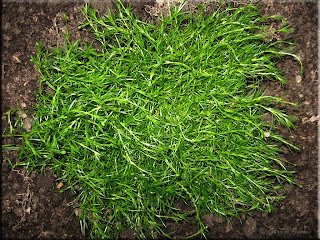
Irish Moss
(Sangia subulata)
I planted Irish moss in a small border bed bordering the garage. The bed is about five feet long, about two feet wide and is tucked between the garage and sidewalk. Like the other border beds here there is a deep layer of gravel for drainage in this bed. Here the Irish moss will be able to spread freely to fill the bed yet be contained from spreading elsewhere. What I like about Irish moss is not only is it low maintenance, it is environmentally friendly. Unlike grass it does not need trimming and because it is so thick, the Irish moss bed should remain relatively weed free. Unlike English ivy, Irish moss does not provide a habitat for rodents nor will I have to worry about it climbing on the brickwork. Irish moss is the perfect solution!
Irish moss (Sangia subulata) is a terrestrial plant also known as Scotch moss (Sangia subulata Aurea) is not a true moss but rather an herb. It forms tight mounds like moss. Chondrus crispus, an edible sea weed that is used as a medicinal herb and thickener is also commonly called Irish moss. Sangia subulata is ideal as a ground cover with low growing bright green foliage and small, star shaped white flowers. Scotch moss has small, star shaped yellow flowers. Irish moss can be grown in any soil while Scotch moss prefers clay soil making both plants ideal for problem areas. Both spread rapidly forming a low growing carpet of green that is deer resistant and tolerant to foot traffic. They are hardy in zones 4 to 9. When planting, space 12 inches apart in full sun to partial shade. Don't over water or allow to dry out. Propagation is done by cutting out sections of an Irish moss clump then pressing the section into moderately moist soil.
If you have a problem area or want to fill the cracks between stepping stones, then do consider this pretty herb. It is sure to be a lovely addition to your gardens.
Happy Gardening!
Garden Gnome
©2007




















I too have planted irish moss in a meditation garden, it is beautiful and the garden looks cool even on the hottest day. Unfortunately, it is starting to die in spots and looks almost mildewed. Any one else have this problem?
ReplyDelete